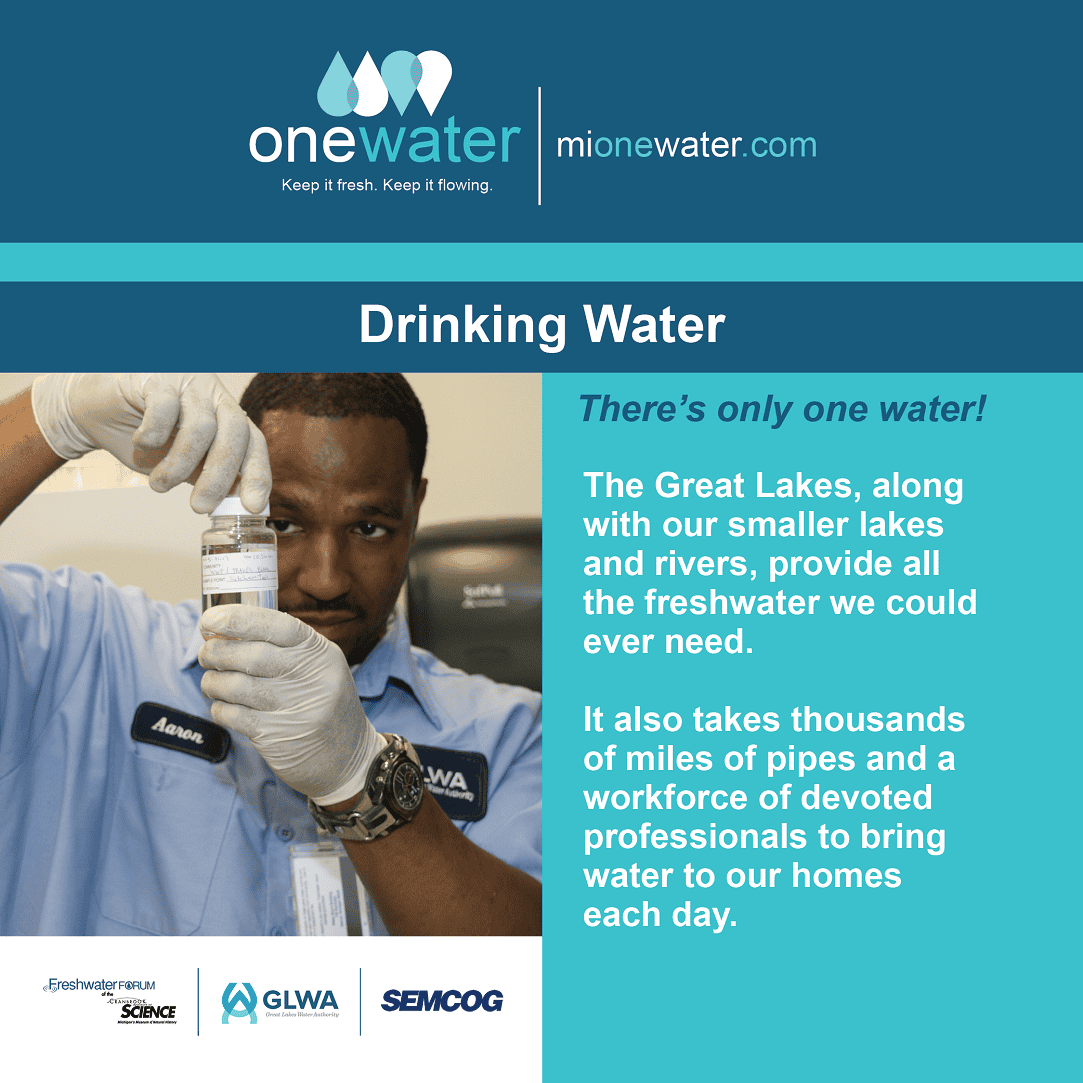In recognition of Great Lakes and Fresh Water Week, I’m taking over the SEMCOG blog with a few posts on underground infrastructure – something I’m really passionate about. I’ve been working on water infrastructure systems since college, and I love talking about things like storm drains, manholes, and valves. While they might seem mundane, these are essential parts of how we manage water. It’s all One Water. Let’s keep it fresh and keep it flowing.
Now that we’ve dealt with the dirty water, let’s talk about the clean stuff! Have you ever thought about where your water comes from when you turn on the tap? When you load up your washer? When you fill-up the tub for a nice relaxing soak? No? Great! Allow me to explain.
Where does our water come from?
In Southeast Michigan, much of our water comes from the Great Lakes. Some communities do get their water from underground reservoirs, but a majority are served from the Lake Huron to Lake Erie corridor, including the Detroit River. There are several water treatment plants that pull water directly from these lakes and rivers, filter and treat the water, and then distribute it to communities and residents.
So much work goes into making sure that all residents in our region have access to safe drinking water. The whole country knows that water quality issues have arisen in Flint and other places. While I won’t get into the challenges experienced in other places, I want to tell you about our region’s water.
Proper treatment enables continued use of aging infrastructure
First of all, many communities that were established around the same time as Flint also have lead service lines. This is not the problem it might seem at first because our drinking water providers use something called corrosion control treatment. This lines drinking water pipes so that the lead and other harsh materials that were commonly used to create infrastructure cannot leach into the clean water we drink and use every day.
Did you know that drinking water providers – all of our communities, unless you’re on a well – are required to test their water at various locations throughout their service area? Did you know that the treatment plants have to meet very strict regulatory levels for the water they put out into the system? They do. Our water is some of the best in the world, and it’s not just because it comes from the Great Lakes. Our treatment operators use best practices and work hard, sometimes 24 hours a day, to make sure we have clean water coming out of our tap.

It’s all connected
Now what happens if – as in my previous Stormwater discussion – a ton of chemicals, fertilizers, and other harmful substances are making their way into our Huron to Erie corridor? The water treatment plant operators have to be vigilant about not only monitoring what they’re putting out in the system but also looking at what’s coming in. If there is an oil spill, the plants have to quickly react and shut down so they don’t draw oil into the plant. At this point, many communities will rely on back-up water in storage tanks or emergency connections to other communities. The chances are that you didn’t know this because our providers do such a great job of keeping our water flowing even when challenges arise.
What happens if it rains heavily on a huge agricultural area that has just put down a ton of fertilizer? That fertilizer will make its way into the water bodies, which can significantly increase the likelihood of an algal bloom. Algal blooms can then cause huge issues with water intake pipes – read this article about the Toledo area if you aren’t familiar with the damage it can cause.
The point of all this is that our water systems are connected. This is why we need to think holistically if we want to keep our water fresh and flowing.
- Let’s have an appreciation for the efforts that go into providing us with perfectly pressurized, clean drinking water at our tap, showerhead, and even toilet.
- Let’s limit our impact on stormwater runoff by capturing it on our properties, disposing of chemicals and hazardous waste and pet waste properly.
- Let’s recognize that street flooding, while inconvenient, might actually be saving us from basement backups!
- Let’s keep our wastewater flowing through the pipes to the recovery facility by only flushing the three Ps: Pee, Poop, (toilet) Paper. No wipes, no hygienic items, no goldfish.
If we make an effort to understand how these systems are connected, we can understand that water infrastructure is really One Water system.

Leave a Reply